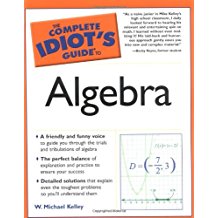Algebra: Translating Words into Math
Translating Words into Math
It's no big surprise that variables act like pronouns, because (believe it or not) math is basically its own language, defined by numeric and logical rules. Therefore, one of the first skills you must master is how to translate regular English into this new (much geekier) math language. For now, I will help you translate English phrases into mathematical phrases, called expressions.
The expressions we'll be translating are very straightforward. For example, the phrase "3 more than an unknown number" becomes the mathematical expression "x + 3." Because the unknown number has no explicitly stated value, we label it with a variable x. To get a value three more than x, simply add 3 to it. If this is tricky to you, just think in terms of a real number example. Ask yourself "What is 3 more than the number 7?" Clearly the answer is 10, and you get that answer via the expression "7 + 3 = 10." So, to get 3 more than an unknown number, replace the known number 7 with the unknown number x.
In this translation problem, the key words were "more than," because they clued you in that addition will be necessary. Each operation has its own cue words, and I've listed them here, with an example for each:
Addition
Kelley's Cautions
Since subtraction is not commutative, be careful to get the order of the numbers right. Notice that "5 less a number" and "5 less than a number" mean completely different things.
- More than/greater than: "11 greater than a number" means "x + 11"
- Sum: "The sum of a number and 6" means "x + 6"
Subtraction
Critical Point
If no symbol is written between two things, multiplication is implied. Thus, 5y means "5 times y" and 2(x + 1) means "2 times the whole expression (x + 1)." Also, from this point forward, I will usually use the symbol "·" to indicate multiplication, because it's too easy to mix up the other multiplication symbol, , with the variable x.
- Fewer than/less than: "7 fewer than a number" means "x - 7"
- Less: "17 less a number" means "17 - x"
- Difference: "The difference of a number and 6" means "x - 6"
Multiplication
You've Got Problems
Problem 1: Translate into a mathematical expression: 5 less than one third of a number.
- Product: "The product of a number and 3" means "x · 3", also written "3x" (since multiplication is commutative, the order in which you write the numbers doesn't matter)
- Of: "Half of 20" means " 12 · 20"
Division
- Quotient: "The quotient of 10 and a number" means "10 · x"
- Fractions: Don't forget that any expression written as a fraction is technically a division problem in disguise.
Example 1: Translate into mathematical expressions.
- (a) The sum of 6 and twice a number
- Solution: The phrase "twice a number" translates into two times the number, or 2x. (Think about ittwice the number 8 would be 2 · 8 = 16.) The word "sum" indicates that you should add 6 and 2x together to get a final answer of 6 + 2x.
- (b) The product of 2 and 3 more than a number
- Solution: You may be tempted to give an answer of 2 · x + 3, but that equals 2x + 3, or "3 more than 2 times a number." You need to use parentheses to keep the x + 3 together like so: 2(x + 3). Now, the 2 is multiplied by the entire x + 3, not just the x.

Excerpted from The Complete Idiot's Guide to Algebra © 2004 by W. Michael Kelley. All rights reserved including the right of reproduction in whole or in part in any form. Used by arrangement with Alpha Books, a member of Penguin Group (USA) Inc.
You can purchase this book at Amazon.com and Barnes & Noble.
